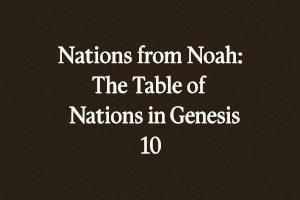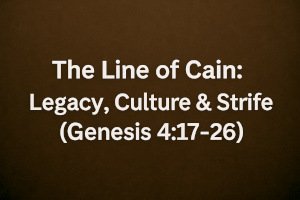Nations from Noah: The Table of Nations in Genesis 10.
After the flood, humanity restarted from one family—Noah and his sons: Shem, Ham, and Japheth. Genesis 10, known as the Table of Nations, offers one of the most profound genealogical records in the Bible. Often skipped over because it reads like a list of names, this chapter actually lays the foundation for the origin of nations, languages, and civilizations.
This isn’t just ancient trivia. It’s a divine record of how God repopulated the earth and divided humanity by family, geography, and purpose. Each name in this passage is a seed—planted by Noah’s sons, growing into empires, people groups, and spiritual legacies.
Table of Contents
The Sons of Noah: A Brief Overview
Genesis 10 outlines how Noah’s three sons became the ancestors of distinct world regions and cultures:
- Japheth: Often associated with Indo-European nations, Japheth’s descendants spread across the coastlands and distant regions. Names like Gomer, Magog, and Javan appear here—tribes and territories that later emerge in biblical prophecy and global migration.
- Ham: From Ham came the builders of early civilizations—Egypt (Mizraim), Babylon (Shinar), and Canaan. Ham’s lineage shaped much of the early biblical narrative, from the Tower of Babel to the land eventually promised to Israel.
- Shem: The most spiritually significant line, Shem’s descendants include Eber—the root of the term “Hebrew.” From Shem would come Abraham, the patriarch of Israel, and eventually, through that line, the Messiah.
Each son represents a stream of humanity, and Genesis 10 shows how those streams began to flow into the world’s landscape.
Why the Table of Nations Matters
Genesis 10 serves as more than a historical account. It’s a spiritual blueprint—showing how God honored family, continuity, and covenant. This list of names acts as a map for tracing both biblical history and the fulfillment of prophetic patterns. Nations rise, fall, clash, and connect—but their roots can often be traced back to this one chapter.
In a world divided by culture, geography, and belief, Genesis 10 reminds us of a powerful truth: we all came from the same place. That sense of origin and shared ancestry carries deep spiritual significance. It calls us to humility, unity, and awareness of God’s sovereign hand across history.
How Genesis 10 Connects to Prophecy
Many of the names in Genesis 10 reappear in prophetic texts. Magog, for example, appears in Ezekiel and Revelation. The descendants of Canaan play a role in the conquest narratives. Egypt and Babylon become spiritual archetypes in both the Old and New Testaments.
The Table of Nations doesn’t just explain where people came from—it helps us understand where history is going. It shows how family lines were preserved, how nations were formed, and how God’s plan has always worked through people, names, and promises.
Final Thoughts
Reading Genesis 10 might feel like trudging through a list, but it’s far more than that. It’s the skeleton of human history, clothed in names we barely pronounce but rooted in destinies that shaped the biblical world and beyond.
This chapter isn’t just about who begat whom. It’s about how God repopulated the earth, honored Noah’s obedience, and set in motion the story of Israel, the gospel, and ultimately — us.
Take a moment to reflect on where you come from. Not just your earthly heritage, but your spiritual one. Genesis 10 shows us that every name matters, and every nation has a thread in God’s great story.

P.S. If this post helped you see Genesis 10 in a new light, subscribe to HolyThreadProject on YouTube for more short-form biblical insights stitched with truth. ✨
#Genesis10 #TableOfNations #NoahsSons #BiblicalGenealogy #BibleStudy #OldTestamentWisdom #SpiritualBlueprint #ScriptureStudy #BiblicalHistory #HolyThreadProject
